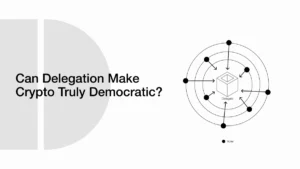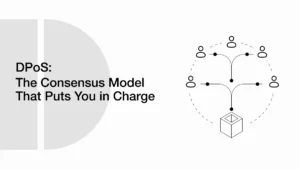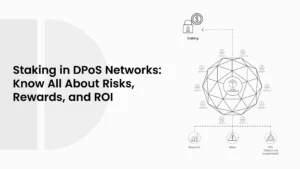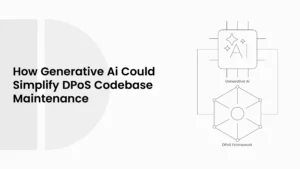Which Cryptocurrencies Use DPoS in 2025? A Beginner’s Guide to DPoS Blockchains
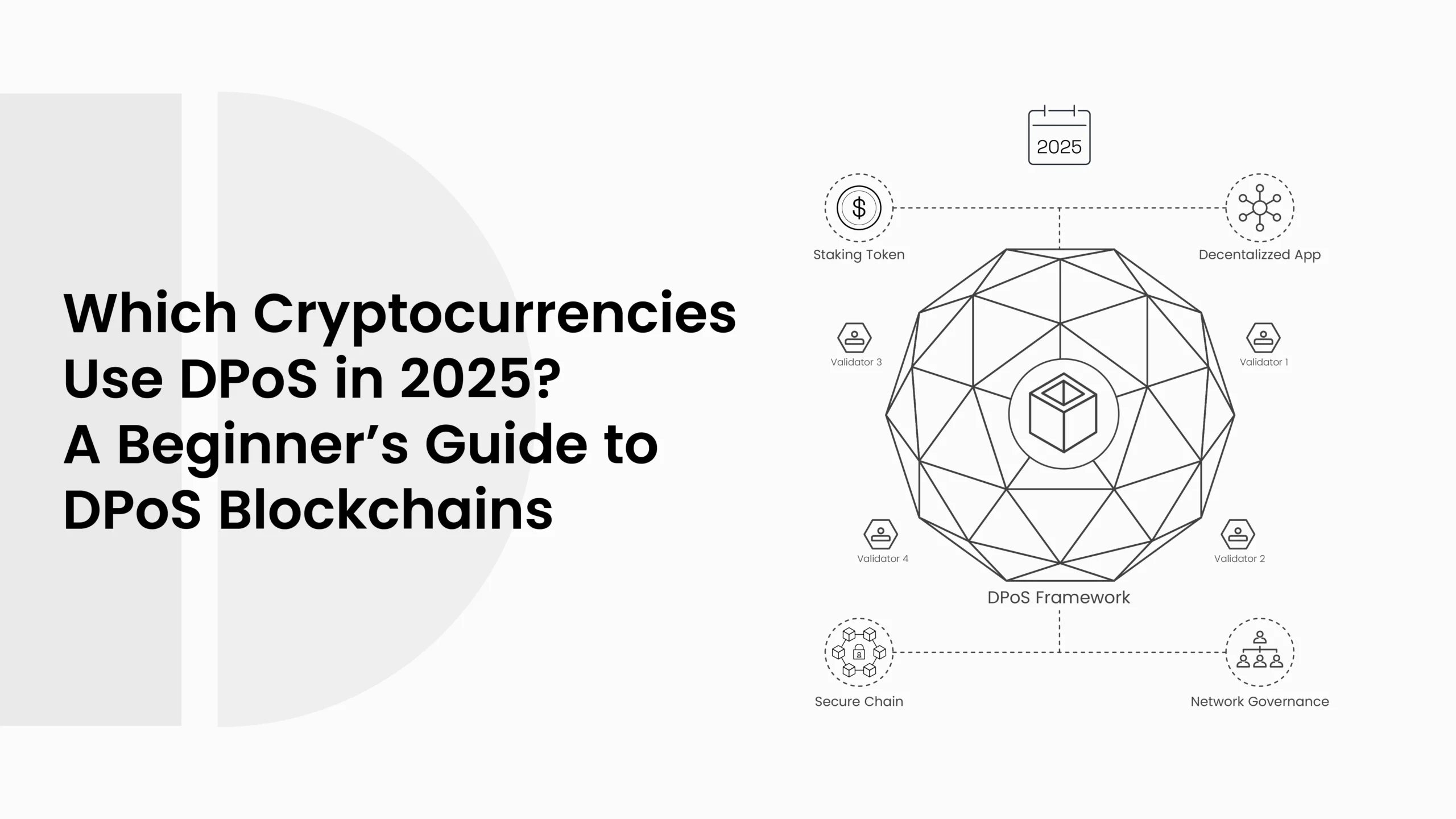
Delegated Proof of Stake (DPoS) is a popular blockchain consensus mechanism nowadays. It was developed to address three major issues that previous blockchains had in terms of slowness, high energy consumption, and lack of community participation.
- What Is Delegated Proof of Stake (DPoS) and Why It Matters
- Which Cryptocurrencies Use Delegated Proof of Stake and How It Works
- EOS
- TRON (TRX)
- Qubetics (TICS)
- BitShares
- Ark
- XDC Network
- Other Notable Mentions
- Conclusion
- Frequently Asked Questions About DPoS
- What is Delegated Proof of Stake?
- How is Delegated Proof of Stake different from Proof of Stake (PoS)?
- Which cryptocurrencies use Delegated Proof of Stake today?
- Why do blockchains pick Delegated Proof of Stake instead of Proof of Work (PoW)?
- Is Delegated Proof of Stake fully decentralized?
- Glossary of DPoS Terms
DPoS also allows token holders to vote on a reduced number of delegates, as opposed to each participant competing to add blocks, as is the case with Proof of Work. These representatives confirm payments, certify the chain, and implement upgrades. This system renders blockchains quicker, less expensive, and more democratic.
In recent years, DPoS has been adopted by many cryptocurrencies, with their own objectives, which can be scalability, governance, or enterprise adoption. The following are some of the most famous ones.
ALSO READ: Rent-Seeking Behavior in DPoS: When Validators Extract Without Contributing
What Is Delegated Proof of Stake (DPoS) and Why It Matters
DPoS allows the token holders to delegate a fixed number of validators, which are often known as delegates or block producers. These representatives create blocks, confirm the transactions, and support the network.
Its design makes it easier to participate: users do not require any costly mining machinery or even a large amount of tokens to participate; all one has to do is to vote on delegates. The representatives will be encouraged to do a good job since failure to do so will make them lose the election.
This balance of efficiency and accountability is why many chains prefer DPoS over traditional Proof of Work (PoW) or Proof of Stake (PoS).
Which Cryptocurrencies Use Delegated Proof of Stake and How It Works
-
EOS
EOS is one of the best-known examples of a DPoS blockchain. EOS, which is developed by Block.one, is based on 21 block producers that are elected by token holders. These block producers verify the transactions and add new blocks.
The system had been designed to accommodate decentralized enterprise-scale applications (dApps). EOS assured high-speed, cheap, and scalable. The comparatively few block producers make the network complete blocks fast, whereas voting makes the process democratic.
EOS shows how DPoS can be used to power complex, high-throughput systems without giving up community governance.
ALSO READ: Blockchain Governance Is Changing: Why DPoS Is Moving Toward DAOs
-
TRON (TRX)
TRON also runs on DPoS, with 27 Super Representatives maintaining the network. The token holders elect these representatives by way of continuous voting.
TRON is concerned with speed and usability, and it is capable of processing up to 2,000 transactions per second. This renders it to be used in entertainment, games, and content-sharing apps.
DPoS helps TRON keep transaction costs near zero while ensuring fast confirmations. Its governance model rewards validators that perform well and remain accountable to the community.
-
Qubetics (TICS)
Qubetics is a new Layer-1 blockchain that recently launched with DPoS as its chosen consensus mechanism. Token holders delegate their stake to validators, who then manage consensus and secure the chain.
Although Qubetics is still early, its use of DPoS reflects a growing trend among newer chains: prioritizing community participation, decentralization, and efficiency. By giving token holders direct influence over validator selection, Qubetics aims to build trust and grow its user base quickly.
-
BitShares
BitShares was the first blockchain to implement Delegated Proof of Stake. BitShares was developed in 2014 by Daniel Larimer (the inventor of DPoS), and it had been around for a long time before it became popular.
BitShares is a decentralized financial system that provides issuance of assets, decentralized exchanges (DEXs), and smart contracts. It has a unique form of governance: it divides the functions into witnesses (block producers) and committee members (who change network parameters).
This dual governance model highlighted the flexibility of DPoS and proved that it could support financial-grade infrastructure.
-
Ark
Ark uses Delegated Proof of Stake to support its mission of making blockchain more interoperable and accessible. With 51 elected delegates, Ark validates transactions and secures its network.
Ark chose DPoS to enable faster protocol updates and prevent long delays or unnecessary forks. Regular delegate elections and public performance tracking keep the governance system transparent and fair.
This model fits Ark’s goal of creating bridges between blockchains, where speed and adaptability are critical.
ALSO READ: DPoS Forks and Upgrades: How Protocol Evolution Really Works
-
XDC Network
The XDC Network takes a slightly hybrid approach. It blends Delegated Proof of Stake with other consensus techniques to support enterprise use cases like trade finance and supply chains.
While not a textbook DPoS system, XDC allows token holders to influence validator selection and governance indirectly. Validators are semi-trusted but operate under community oversight.
This renders XDC appropriate to regulated settings where efficiency and finality are the most important factors. XDC demonstrates the way in which DPoS principles can be modified according to the practical requirements by merging speed, transparency, and enterprise focus.
Other Notable Mentions
To satisfy particular market demands, a few other networks have made use of the DPoS framework. DPoS is also used by WAX, a chain that is derived from EOSIO, to facilitate virtual asset management and NFT trading. Before being split off into Hive, Steem used DPoS to run a blockchain-based social media network that let curators and content producers get paid directly through community voting.
Each of these platforms selected DPoS to achieve fast block times, reduce environmental impact, and enable dynamic governance mechanisms that can adapt over time.
ALSO READ: The Future of Validator Nodes in DPoS: Hardware, Geography, and Centralization
Conclusion
Delegated Proof of Stake has since ceased to be an experimental option in BitShares and is now a mainstream option in global blockchains such as EOS, TRON, Ark, and XDC. The trend is being followed by newer projects such as Qubetics, which indicates that Delegated Proof of Stake will be applicable in the next wave of blockchain use.
Its ability to combine speed, scalability, and democratic governance makes DPoS one of the most adaptable consensus models in the industry. As more networks expand into real-world use cases, DPoS is likely to remain a key part of blockchain’s future.
Frequently Asked Questions About DPoS
What is Delegated Proof of Stake?
In Delegated Proof of Stake, people who hold tokens give their votes to a small group of delegates. These delegates are the ones who keep the blockchain safe, check the transactions, and make the new blocks.
How is Delegated Proof of Stake different from Proof of Stake (PoS)?
In normal PoS, anyone with tokens can join to check transactions if they lock coins. But in Delegated Proof of Stake, only a few chosen delegates do this job. That makes the system faster and works more smoothly.
Which cryptocurrencies use Delegated Proof of Stake today?
Big names like EOS, TRON, BitShares, Ark, and XDC Network use DPoS. Some new blockchains like Qubetics also started with DPoS to be faster and let people vote for who runs the network.
Why do blockchains pick Delegated Proof of Stake instead of Proof of Work (PoW)?
DPoS is quicker, uses less energy, and gives token holders a voice in how things go. PoW needs heavy mining computers and is much slower to finish a transaction.
Is Delegated Proof of Stake fully decentralized?
Not really. Only a small number of delegates control making blocks, so some people say it is too centralized. But token holders can vote them out and bring new ones, so there is still some balance.
Glossary of DPoS Terms
- Delegate / Block Producer: A validator chosen by token holders to confirm transactions and add blocks.
- Super Representatives (TRON): TRON’s version of delegates; 27 elected nodes that secure the network.
- Witness (BitShares): Block producers in the BitShares system.
- Committee Member (BitShares): Elected participants who adjust network rules and parameters.
- Validator (General Term): A node that confirms transactions and keeps the blockchain secure.
- Governance: The process of making decisions in a blockchain, often through token holder voting.
- Stake Delegation: When token holders assign their voting power to a delegate or validator.
- Block Finality: The point at which a transaction is locked in and cannot be reversed.
- Hybrid DPoS (XDC): A mixed model where trusted validators operate under community oversight.
- Fork: A change in the blockchain rules that may split it into two versions.

